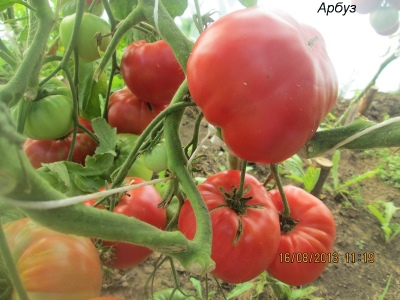
- Authors: USA
- Name synonyms: Watermelon
- Category: grade
- Appointment: fresh consumption, for whole-fruit preservation, for juice, for ketchup and tomato paste
- Ripening period: mid-early
- Ripening time, days: 110-115
- Growing conditions: for open ground, for film greenhouses, for greenhouses
- Transportability: for short distances
- Bush size: tall
- Bush height, cm: 180
Fans of fleshy varieties of tomatoes in early spring begin to look for varieties suitable for planting. One of the most popular varieties of fleshy tomatoes is Watermelon.
Description of the variety
The homeland of this mouth-watering variety is the United States of America. The Watermelon variety gained popularity among domestic gardeners only a few years ago. Despite this, it is already widely used both for private cultivation and for mass production.
The variety is perfect both for planting in open soil and for all kinds of greenhouses, including from a film.
The plant has tall bushes with a height of 180 centimeters. The leaves of the tomato are similar to the potato variety.
When a tomato is formed, up to 4 stems appear.
The main qualities of the fruit
The fruits of the watermelon variety are medium or large in size, from 300 to 400 grams in some cases. The shape of the fruit of Watermelon varies according to size, but is predominantly flat, flat and round.
The color of ripe tomatoes is closer to a raspberry hue. This appearance is not typical for most tomato varieties.
Tomatoes can be classified as multichamber, which are characterized by an abundant number of seeds.
Fruit should not be transported over long distances.
Taste characteristics
Ripe watermelon tomatoes are distinguished by their tender and extremely juicy, but at the same time, fleshy pulp. The fruits have a pronounced sweet taste.
American farmers nicknamed this type of steak because of the similarity to a meat dish. The pulp has a delicate pleasant aroma. The surface of the vegetables is pleasant to the touch, with a smooth, thin skin.
The fruits are great for salads, appetizers, first and main courses, ketchup, sauces and pastes, tomato juice, canning.
Ripening and fruiting
Seedlings of Watermelon can be sown from the middle of the last winter month, if we are talking about early-type production. In March, plantings are carried out for the medium early format. In late May, seedlings are usually planted for late harvests.
According to the standard, Watermelon is considered to be medium early in terms of ripening. This period usually does not exceed 115 days, but lasts at least 110 days.
Yield
Watermelon tomatoes are officially registered as a greenhouse variety, making them suitable for any growing region. In areas located in the southern regions, you can safely plant bushes of plants in open ground, subject to high-quality support.
Farmers specializing in the cultivation of this variety claim high yields, up to 20 kg per bush, subject to all conditions of plant care.
The timing of planting seedlings and planting in the ground
Before sending the bushes into open ground, they should be cultivated using the seedling method, regardless of weather conditions.
The seeds of the tomato variety Watermelon are planted according to the classical scheme, which is used for most types of tomatoes. If you put each of the seeds in special peat tablets, you don't have to waste time on the picking stage. Landing is carried out directly in the indicated tablets.
The formation of seedlings in terms of time takes at least one and a half months. Be sure to check the weather forecast as frost can damage weak bushes. If planting is carried out in greenhouses, it is only important to take into account the number of leaves on each individual bush, which should reach at least 6. In addition, the presence of inflorescences is important.

Growing tomato seedlings is an extremely important process, because it largely depends on whether the gardener can harvest at all. All aspects must be taken into account, from seedbed preparation to planting in the ground.
Landing scheme
At the initial stage, the soil is combined with humus, after which it is dug up. It is important to loosen heavy soil by adding a small amount of sand. Since the bushes are quite voluminous and tall, only 3 holes are enough for each square meter, placed in a checkerboard pattern. The optimal layout in this case is 40 x 60 cm.
The bottom of the holes should be flavored with ash in an amount of no more than one tablespoon, and then add special fertilizers combined with the soil.
Experienced gardeners recommend planting tomatoes directly with the soil in which they grew for the first time. After planting, you should cover the hole with earth and add a little water.

Growing and caring
So that the stems do not break under the weight of massive fruits, it is important to pick up a strong support, tie up bushes and branches.
It is important to remove excess shoots in order to preserve the maximum amount of minerals for the vegetables. It is also customary to cut the top of the stem in order to adjust its height. Leaves placed close to the soil are important to cut off in a timely manner.
Algorithm for processing bushes:
the use of organic and mineral fertilizers;
regular loosening of the soil;
timely removal of weeds from the beds;
root watering of plants with warm water, without touching the bushes themselves;
mulch the soil near the bushes to keep the water from evaporating.




A plant needs different micronutrients at each stage of growth. All fertilizers can be divided into two groups: mineral and organic. Folk remedies are often used: iodine, yeast, bird droppings, eggshells.
It is important to observe the rate and period of feeding.This also applies to folk remedies and organic fertilizers.



























































































